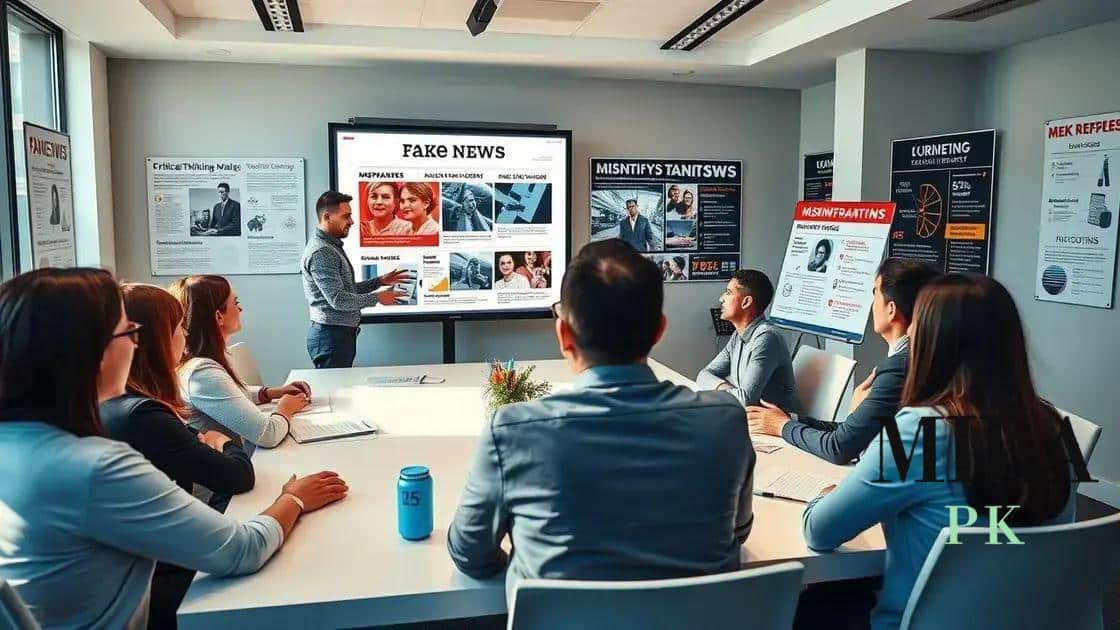Strategies to secure systems from disinformation in 2025

Strategies to secure systems from disinformation in 2025 involve developing effective response plans, training teams to recognize misinformation, and fostering clear communication to mitigate the impact of false information.
Strategies to secure systems from disinformation in 2025 are crucial as misinformation continues to evolve. Wondering how to protect your organization? Let’s dive into valuable approaches.
Understanding disinformation and its impact
Understanding disinformation and its impact is essential in today’s world. Many individuals and organizations are unaware of how misinformation spreads and affects decision-making processes. By comprehending this phenomenon, we can better protect ourselves and our communities.
The Nature of Disinformation
Disinformation refers to false information that is deliberately spread with the intent to deceive. It can take many forms, such as fake news articles, misleading social media posts, or altered images. Recognizing disinformation requires critical thinking and a keen eye for detail.
- Self-interest of the source
- Emotional appeals in messages
- Manipulative visuals
- Lack of credible references
People often encounter disinformation in their daily lives through social media, news outlets, and other platforms. It can lead to confusion, polarized opinions, and even conflict within communities. By noticing the signs of misinformation, we can navigate information more effectively.
Impact on Society
The effects of disinformation are profound. It not only disrupts communication but can also alter public perception on important issues like health or politics. For instance, during a health crisis, disinformation regarding medical advice can lead to serious consequences.
Furthermore, disinformation can undermine trust in institutions. When citizens are bombarded with conflicting messages, they may start to question the credibility of news outlets and government sources. This erosion of trust can have long-lasting effects on democracy and social cohesion.
Addressing disinformation requires a collective effort. Awareness campaigns, improved media literacy education, and robust fact-checking initiatives can play a significant role in mitigating its impact. As individuals, staying informed and questioning the information we receive can contribute to a healthier information ecosystem.
Key technologies to combat disinformation

Key technologies to combat disinformation play a vital role in today’s digital landscape. As misinformation evolves, understanding and utilizing these technologies is crucial for ensuring accurate information dissemination.
Artificial Intelligence and Machine Learning
Artificial intelligence (AI) and machine learning (ML) are at the forefront of identifying disinformation. These technologies analyze vast amounts of data, helping to recognize patterns in the spread of false information. By training algorithms, platforms can detect increasingly sophisticated attempts at manipulation.
- Identifying sources of disinformation
- Flagging misleading content before it spreads
- Improving accuracy in news reporting
- Providing users with more reliable information
AI and ML enhance the reliability of online platforms by enabling faster responses to disinformation. As these technologies improve, their ability to keep users informed and safe increases significantly.
Blockchain Technology
Another innovative solution is blockchain technology. By providing a decentralized method of verifying information, blockchain can create a transparent record of content origin. Each piece of information can be traced back to its source, helping users identify whether it’s credible or not.
The inherent security features of blockchain mean that once information is added, it cannot be altered without consensus. This characteristic combats disinformation by ensuring that users can trust the authenticity of the information they receive.
Combining AI, ML, and blockchain creates a more resilient framework against disinformation. However, continuous education on media literacy is equally important. Users must be equipped to interpret the information they encounter.
Collaboration between technology companies, journalists, and governmental bodies can foster tools to fight disinformation effectively. Innovative solutions supported by technology, alongside informed citizens, can create a healthier information environment.
Best practices for organizations
Best practices for organizations are essential in the fight against disinformation. Organizations must actively engage in strategies that promote truth and transparency to create a more informed public.
Developing a Clear Policy
Having a clear policy regarding disinformation is crucial. This policy should outline the organization’s stance on misinformation and clearly define how to address it. By articulating these guidelines, organizations can set expectations for their staff and followers.
- Outline procedures for identifying disinformation
- Establish protocols for responding to misinformation
- Ensure regular updates to the policy as new challenges arise
- Incorporate training sessions for all employees
With a solid policy in place, organizations can act quickly and effectively when confronted with misinformation.
Investing in Training
Training staff on media literacy is another best practice. Employees should learn how to identify reliable sources and detect disinformation. This knowledge empowers them to make informed decisions and contribute to a culture of truth within the organization.
Regular workshops can cultivate skills in critical thinking, allowing employees to evaluate information effectively. By being equipped to handle disinformation, they become better advocates for accurate communication.
Organizations can also involve external experts who can provide deeper insights into combating disinformation and share the latest technological tools for verification.
Encouraging Open Communication
Encouraging open communication between teams is vital for tackling disinformation. By creating an environment where employees feel safe to voice concerns or share information, organizations can better identify potential misinformation before it spreads.
Regular meetings or check-ins can strengthen relationships and foster collaboration. When team members support each other in media literacy efforts, they can collectively enhance the organization’s overall resilience.
Ultimately, the fight against disinformation requires a concerted effort. By implementing these best practices, organizations can position themselves as trusted sources of information and contribute to a healthier information landscape.
Training teams to recognize misinformation

Training teams to recognize misinformation is crucial in today’s information-driven world. When employees can identify false information, they become more effective in promoting accurate communication within their organizations.
Establishing a Training Program
Creating a structured training program is the first step. This program should cover the basics of disinformation and how it spreads. Effective sessions will equip employees with the skills they need to challenge misinformation head-on.
- Define misinformation and its impacts
- Showcase real-life examples of disinformation
- Teach critical thinking and evaluation skills
- Provide tools for fact-checking information
With informative sessions, team members can better understand how to spot inaccuracies in news and social media.
Interactive Workshops
Interactive workshops can enhance learning experiences. Engaging scenarios allow participants to practice identifying misinformation in a safe space. These exercises encourage discussion and feedback, making the experience more impactful.
Techniques such as group activities, role-playing, and case studies can stimulate critical thinking. Employees can work together to analyze information and discuss their findings, reinforcing their learning.
Regularly updating training materials is also important. As disinformation methods evolve, so should the training programs. Employees need the latest information to stay vigilant.
Creating a Culture of Awareness
Fostering a culture of awareness within the organization encourages ongoing vigilance against disinformation. Encourage team members to share their experiences and insights regularly. When employees discuss what they have learned, it reinforces the training.
Incorporating quick reference guides or toolkits that employees can access anytime can also support them in their daily tasks. These materials should highlight key indicators of misinformation and reliable sources for verification.
Ultimately, organizations that invest in training their teams to recognize misinformation will emerge as leaders in promoting truthful communication. This proactive approach not only protects the organization but also contributes to a well-informed community.
Developing an effective response plan
Developing an effective response plan is vital for organizations facing disinformation. A well-structured plan helps teams respond quickly and efficiently when misinformation surfaces. This proactive approach can mitigate potential damage.
Assessing Potential Threats
The first step in creating a response plan is assessing potential threats. Organizations should identify the types of disinformation most likely to affect them. Understanding these threats will help teams prepare for various scenarios.
- Identify key topics currently facing misinformation
- Analyze past incidents of disinformation related to the organization
- Evaluate the organization’s vulnerabilities
- Engage with stakeholders to gather insights
By evaluating these factors, organizations can tailor their response plans to address specific risks.
Creating a Communication Strategy
A solid communication strategy is essential in an effective response plan. The plan should outline how the organization will communicate internally and externally when disinformation arises. Clear messaging is crucial for maintaining trust.
Key components of the communication strategy include:
- Designating a spokesperson for media inquiries
- Establishing a timeline for responses
- Drafting template communications for different scenarios
- Utilizing multiple channels for message distribution
This organized approach ensures that information flows efficiently and accurately, reducing confusion.
Training and Practice
Training team members on the response plan is essential. Regular practice sessions will ensure that everyone understands their roles during a crisis. Mock scenarios can help teams prepare for real-life situations and build confidence.
Effective training should emphasize:
- Understanding the response plan’s components
- Recognizing the signs of misinformation
- Practicing communication techniques
- Encouraging collaboration among team members
By practicing regularly, teams will be more prepared to respond promptly and effectively when faced with disinformation.
In conclusion, developing an effective response plan is crucial for organizations dealing with disinformation. By assessing threats, creating a communication strategy, and training employees, organizations can protect their reputation and ensure accurate information is disseminated promptly.
In summary, addressing disinformation requires a multi-faceted approach. Organizations must develop effective response plans, train their teams, and promote a culture of transparency. By taking these steps, they can combat the spread of misinformation and protect their integrity. Staying informed and vigilant is essential in this constantly changing landscape. With the right tools and strategies, organizations can mitigate the effects of disinformation and foster a more informed community.
FAQ – Frequently Asked Questions about Strategies to Secure Systems from Disinformation
Why is it important for organizations to address disinformation?
Addressing disinformation is crucial to maintaining trust, protecting reputation, and ensuring accurate information is shared within and outside the organization.
What are the first steps to developing a response plan for disinformation?
The first steps include assessing potential threats, creating a communication strategy, and training your team to recognize misinformation.
How can training help teams combat misinformation?
Training equips teams with the skills to identify, respond to, and combat misinformation effectively, creating a more informed workforce.
What role does communication play in managing disinformation?
Clear communication ensures accurate information flow, reduces confusion during crises, and helps maintain stakeholder confidence.





